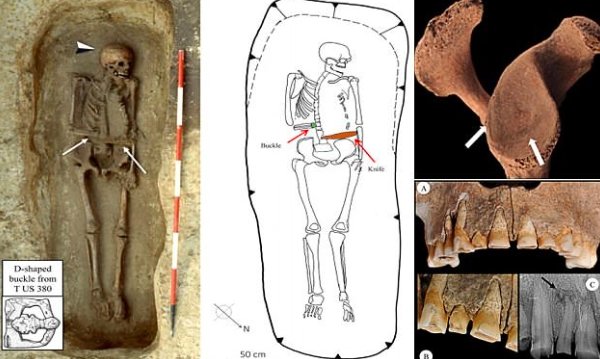In a remarkable archaeological discovery, researchers have uncovered the skeleton of a medieval warrior in northern Italy who used a knife as a prosthetic limb. This extraordinary find, dating back to the 6th century, reveals the ingenuity and resilience of a man who adapted to his severe injury by attaching a bladed weapon to his amputated arm. The skeleton, found in a Longobard necropolis, provides a fascinating glimpse into the life and survival strategies of medieval warriors.
The Discovery and Its Significance
Archaeologists discovered the skeleton in a Longobard necropolis in northern Italy, a site known for its historical significance. The warrior’s remains were found with a knife attached to the stump of his amputated right arm. This unique prosthetic device was secured using a cap, buckle, and leather straps, showcasing the resourcefulness of the individual. The discovery is significant as it highlights the advanced medical and adaptive techniques used during the medieval period.
The skeleton, identified as a male between 40 and 50 years old, showed signs of having survived a traumatic amputation. Researchers believe the hand was removed due to blunt force trauma, possibly from a battle or an accident. The presence of the knife prosthesis indicates that the warrior continued to participate in combat or daily activities despite his disability. This find sheds light on the resilience and adaptability of medieval warriors, who often faced life-threatening injuries.

Further analysis of the skeleton revealed that the man had developed calluses and bone spurs, suggesting frequent use of the prosthetic device. His teeth also showed significant wear, likely from using them to tighten the straps of the prosthesis. These findings provide valuable insights into the daily life and challenges faced by individuals with disabilities in the medieval period.
Historical Context and Cultural Implications
The Longobard necropolis, where the skeleton was found, dates back to the 6th century and is a significant archaeological site. The Longobards were a Germanic people who ruled over parts of Italy during the early Middle Ages. The discovery of the warrior’s skeleton with a prosthetic weapon adds a new dimension to our understanding of Longobard culture and their approach to disability and warfare.
The use of a knife as a prosthetic limb is a testament to the warrior’s determination to continue fighting despite his injury. This adaptation reflects the warrior-specific culture of the Longobards, where combat and physical prowess were highly valued. The presence of other weapons and artifacts in the necropolis further supports the idea that this society placed great importance on martial skills and resilience.
The discovery also raises questions about the medical knowledge and practices of the time. The successful attachment and use of a prosthetic device suggest a certain level of medical expertise and understanding of biomechanics. This find challenges the common perception of medieval medicine as primitive and highlights the innovative solutions developed by individuals to cope with their injuries.
Implications for Modern Archaeology
The discovery of the medieval skeleton with a prosthetic weapon has significant implications for modern archaeology and our understanding of disability in historical contexts. It provides a rare example of how individuals adapted to severe injuries and continued to participate in their communities. This find also underscores the importance of interdisciplinary research, combining archaeology, anthropology, and medical science to uncover the full story behind such discoveries.
Modern technology, such as CT scans and 3D modeling, played a crucial role in analyzing the skeleton and understanding the use of the prosthetic device. These tools allowed researchers to examine the wear patterns on the bones and teeth, providing detailed insights into the warrior’s daily life and the challenges he faced. The integration of advanced technology in archaeological research continues to enhance our ability to uncover and interpret historical artifacts.
The discovery also highlights the need for continued exploration and excavation of historical sites. Each new find adds to our understanding of past societies and their approaches to challenges such as disability and injury. The medieval warrior with a prosthetic weapon serves as a powerful reminder of human resilience and ingenuity, inspiring further research and exploration in the field of archaeology.













